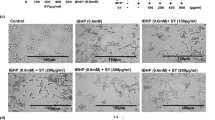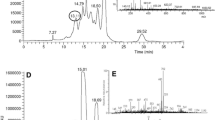Abstract
Skin cancer is the most common malignancy in the world and also one of the major causes of death worldwide. The toxic environmental pollutant 7,12-dimethylbenz[a]anthracene (DMBA) is a skin-specific carcinogen. Tannic acid (TA) is reported to be effective against various types of chemical-induced toxicities and carcinogenesis as well. In the present study, we have evaluated the therapeutic potential of tannic acid in DMBA + croton oil-induced skin cancer in Swiss albino mice. Protective effect of TA against skin cancer was evaluated in terms of antioxidant enzymes activities, lipid peroxidation, histopathological changes and expression of inflammation and early tumour markers. DMBA + croton oil causes depletion of antioxidant enzymes (p < 0.001) and elevation of early inflammatory and tumour promotional events. TA prevents the DMBA + croton oil-induced toxicity through a protective mechanism that involves the reduction of oxidative stress as well as COX-2, i-NOS, PCNA protein expression and level of proinflammatory cytokine such as IL-6 release at a very significant level (p < 0.001). It could be concluded from our results that TA attenuates DMBA + croton oil-induced tumour promotional potential possibly by inhibiting oxidative and inflammatory responses and acts as antioxidant, anti-inflammatory and antiproliferative agent.







Similar content being viewed by others
References
Greenwald P, Milner JA, Anderson DE et al (2002) Micronutrient in cancer chemoprevention. Cancer Metastasis Rev 21:217–230
Soria JC, Kim ES, Fayette J et al (2003) Chemoprevention of lung cancer. Lancet Oncol 4:659–669
Cancer Research UK (2008). Skin cancer overview. http://info.Cancerresearchuk.org/healthyliving/sunsmart/skincancer/. Accessed 17 November 2008
Wenk J, Brenneisen P, Meewes C, Wlaschek M, Peters T et al (2001) UV-induced oxidative stress and photoaging. Curr Probl Dermatol 29:83–94
Stefanie K, Ulrike B, Dennis N et al (2010) Quantification of ETS expose in hospitality workers who have never smoked. Environ Health 49:1096–1099
Saha D, Hait M (2012) An Ontological design: two stage mouse skin carcinogenesis induced by DMBA and promoted by croton oil. Asian J Res Pharm Sci 2:01–03
Di Giovanni J (1992) Multistage carcinogenesis in mouse skin. Pharm Ther 47:63–128
Das RK, Bhattacharya S (2004) Inhibition of DMBA-croton oil two-stage mouse skin carcinogenesis by diphenylmethyl selenocyanate through modulation of cutaneous oxidative stress and inhibition of nitric oxide production. Asian Pac J Cancer 5:151–158
Berenblum I (1941) The mechanism of carcinogenesis: a study of the significance of the co-carcinogenic action and related phenomena. Cancer Res 1:807–814
Stoner GD, Mukhtar H (1995) Polphenols as cancer chemopreventive agents. J Cell Biochem 22:169–180
Block G, Patterson B, Subar A (1992) Fruit, vegetables and cancer prevention: a review of the epidemiological evidence. Nut Cancer 18:1–29
Khan NS, Ahmad A, Hadi SM (2000) Antioxidant, prooxidant properties of tannic acid and its binding to DNA. Chem Biol Interact 125:177–189
Ferguson LR (2001) Role of plant polyphenols in genomic stability. Mutat Res 75:89
Wu LC, Fan NC, Lin MH et al (2008) Anti-inflammatory effect of spilanthol from Spilanthes acmella on murine macrophage by down-regulating LPS-induced inflammatory mediators. J Agric Food Chem 56:2341–2349
Andrade RG Jr, Dalvi LT, Silva JM Jr et al (2005) The antioxidant effect of tannic acid on the in vitro copper-mediated formation of free radicals. Arch Biochem Biophys 437:1–9
Chen SC, Chung KT (2000) Mutagenicity and antimutagenicity studies of tannic acid and its related compounds. Food Chem Toxicol 38:1–5
Huang WY, Cai YZ, Zhang Y (2010) Natural phenolic compounds from medicinal herbs and dietary plants: potential use for cancer prevention. Nutr Cancer 62:1–20
Van der Logt EM, Roelofs HM, Nagengast FM et al (2003) Induction of rat hepatic and intestinal UDP-glucuronosyltransferases by naturally occurring dietary anticarcinogens. Carcinogenesis 24:1651–1656
Ahmad ST, Sultana S (2012) Tannic acid mitigates cisplatin-induced nephrotoxicity in mice. Human Exp Toxicol 31:145–156
Khan NS, Hadi SM (1998) Structural features of tannic acid important for DNA degradation in the presence of Cu(II). Mutagenesis 13:217
Newmark H (1987) Plant phenolics as inhibitors of mutational and precarcinogenic events. Can J Physiol Pharmacol 65:461–466
Baer-Dubowska W, Gnojkowski J, Fenrych W (1997) Effect of tannic acid on benzo[a]pyrene-DNA adduct formation in mouse epidermis: comparison with synthetic gallic acid esters. Nutr Cancer 29:42–47
Baer-Dubowska W, Szaefer H, Krajka-Kuzniak V (1998) Inhibition of murine hepatic cytochrome P450 activities by natural and synthetic phenolic compounds. Xenobiotica 28:735–743
Krajka-Kuźniak V, Baer-Dubowska W (2003) The effects of tannic acid on cytochrome P450 and phase II enzyme in mouse liver and kidney. Toxicol Lett 143:209–216
Szaefer H, Jodynis-Liebert J, Cichocki M et al (2003) Effect of naturally occurring plant phenolics on the induction of drug metabolizing enzymes by o-toluidine. Toxicology 186:67–77
Ignatowicz E, Balana B, Vulimiri SV et al (2003) The effect of plant phenolics on the formation of 7,12-dimetylbenz[a]antracene-DNA adducts and TPA-stimulated polymorphonuclear neutrophils chemiluminescence in vitro. Toxicology 189:199–209
Gali HU, Perchellet EM, Perchellet JP (1991) Inhibition of tumor promoter induced ornithine decarboxylase activity by tannic acid and other polyphenols in mouse epidermis in vivo. Cancer Res 51:2820–2825
Nafees S, Ahmad ST, Arjumand W et al (2013) Carvacrol ameliorates thioacetamide-induced hepatotoxicity by abrogation of oxidative stress, inflammation and apoptosis in liver of Wistar rats. Hum Exp Toxicol 32(12):1292–1304
Jollow DJ, Mitchell JR, Zampaglione N et al (1974) Bromobenzene induced liver necrosis: protective role of glutathione and evidence for 3,4-bromobenzene oxide as the hepatotoxic intermediate. Pharmacology 11:151–169
Claiborne A (1985) Catalase activity. In: Greenwald RA (ed) CRC handbook of methods in oxygen radical research. CRC, Boca Raton, pp 283–284
Rashid S, Ali N, Nafees S et al (2013) Alleviation of doxorubicin-induced nephrotoxicity and hepatotoxicity by chrysin in Wistar rats. Toxicol Mech Methods 23(5):337–345
Habig WH, Pabst MJ, Jakoby WB (1974) Glutathione-S-transferases: the first enzymatic step in mercapturic acid formation. J Biol Chem 249:7130–7139
Carlberg I, Mannervik B (1975) Glutathione level in rat brain. J Biol Chem 250:5475–5480
Nafees S, Ahmad ST, Arjumand W et al (2013) Hibiscus rosa sinensis alleviates thioacetamide induced acute hepatotoxicity in Wistar rats. Int J Drug Dev Res 5(1):1–10
Pick E, Keisari Y (1981) Superoxide anion and H2O2 production by chemically elicited peritoneal macrophages–induction by multiple non-phagocytic stimuli. Cell Immunol 59:301–308
Lowry OH, Rosebrough NJ, Farr A et al (1951) Protein measurement with the Folin phenol reagent. J Biol Chem 193:265–275
Patel R, Krishnan R, Ramchandani A et al (2008) Polymeric black tea polyphenols inhibit mouse skin chemical carcinogenesis by decreasing cell proliferation. Cell Prolif 41:532–553
Athar M, Khan WA, Mukhtar H (1989) Effect of dietary tannic acid on epidermal, lung, and forestomach polycyclic aromatic hydrocarbon metabolism and tumorigenicity in Sencar mice. Cancer Res 49:5784–5788
Gali HU, Perchellet EM, Klish DS et al (1992) Hydrolyzable tannins: potent inhibitors of hydroperoxide production and tumor promotion in mouse skin treated with 12-O-tetradecanoylphorbol-13-acetate in vivo. Int J Cancer 51:425–432
Ahmad ST, Arjumand W, Seth A et al (2011) Preclinical renal cancer chemopreventive efficacy of geraniol by modulation of multiple molecular pathways. Toxicology 290:69–81
Rubin H (2001) Selected cell and selective microenvironment in neoplastic development. Cancer Res 61:799–807
Nakamura Y, Kozuka M, Naniwa K et al (2003) Arachidonic acid cascade inhibitors modulate phorbol ester-induced oxidative stress in female ICR mouse skin: differential roles of 5-lipoxygenase and cyclooxygenase-2 in leukocyte infiltration and activation. Free Radic Biol Med 35:997–1007
Gerber M, Astre C, Segala C et al (1997) Tumor progression and oxidant–antioxidant status. Cancer Lett 114:211–214
Saintot M, Astre C, Pujol H (1996) Tumor progression and oxidant antioxidant status. Carcinogenesis 17:1267–1271
Sharma S, Sultana S (2004) Modulatory effect of soy isoflavones on biochemical alterations mediated by TPA in mouse skin model. Food Chem Toxicol 42:1669–1675
Tiwari M, Kakkar P (2009) Plant derived antioxidants—GOH and camphene protect rat alveolar macrophages against t-BHP induced oxidative stress. Toxicol Vitro 23:295–301
Pillai CK, Pillai KS (2002) Antioxidants in health. Indian J Physiol Pharmacol 46:1–5
Wei H, Wei L, Frenkel K et al (1993) Inhibition of tumour promoter induced hydrogen peroxide formation in vitro and in viva by genistein. Nutr Cancer 20:1–12
Stanley PL, Steiner S, Havens M et al (1991) Mouse skin inflammation induced by multiple topical applications of 12-O-tetradecanoylphorbol-13-acetate. Skin Pharmacol 4:262–271
Pence BC, Reiners JJ Jr (1987) Murine epidermal xanthine oxidase activity correlation with the hyperplasia induced by tumor promoter. Cancer Res 47:6388–6392
Sun Y (1990) Free radicals, antioxidant enzymes and carcinogenesis. Free Rad Biol Med 8:5839
Murakami A, NakamuraY Torikai K et al (2000) Inhibitory effect of citrus nobiletin on Phorbol ester-induced skin inflammation, oxidative stress, and tumor promotion in mice. Cancer Res 60:5059–5066
Slaga TJ (1984) Mechanisms involved in two-stage carcinogenesis in mouse skin. In: Slaga TJ (ed) Mechanisms of tumor promotion, vol 2. CRC Press, Boca Raton, pp 1–16
Kundu JK, Surh YJ (2008) Inflammation: gearing the journey to cancer. Mutat Res 659:15–30
Bravo R (1986) Synthesis of the nuclear protein cyclin (PCNA) and its relationship with DNA replication. Exp Cell Res 163:287–293
Bravo R, Frank R, Blundell PA et al (1987) Cyclin/PCNA is the auxiliary protein of DNA polymerase-delta. Nature 326:515–517
Jaskulski D, de Riel JK, Mercer WE et al (1988) Inhibition of cellular proliferation by antisense oligodeoxynucleotides to PCNA cyclin. Science 240:15446
Joseph LB, Gerecke DR, Heck DE et al (2011) Structural changes in the skin of hairless mice following exposure to sulfur mustard correlate with inflammation and DNA damage. Exp Mol Pathol 91:515–527
Moore RJ, Owens DM, Stamp G et al (1999) Mice deficient in tumor necrosis factor-alpha are resistant to skin carcinogenesis. Nat Med 5:828–831
Tricot G (2000) New insights into role of microenvironment in multiple myeloma. Lancet 355:248–250
Vidal-Vanaclocha F, Fantuzzi G, Mendoza L et al (2000) IL-18 regulates IL-1 beta-dependent hepatic melanoma metastasis via vascular cell adhesion molecule-1. Proc Natl Acad Sci USA 97:734–739
Smith CW, Chen Z, Dong G et al (1998) The host environment promotes the development of primary and metastatic squamous cell carcinomas that constitutively express proinflammatory cytokines IL-1alpha, IL-6, GM-CSF, and KC. Clin Exp Metastasis 16:655–664
Philip M, Rowley DA, Schreiber H (2004) Inflammation as a tumor promoter in cancer induction. Semin Cancer Biol l14:433–439
Surh YJ, Chun KS, Cha HH et al (2001) Molecular mechanisms underlying chemopreventive activities of anti-inflammatory phytochemicals: down-regulation of COX-2 and i-NOS through suppression of NF-κB activation. Mutat Res 480–481:243–268
Kim Y, Fischer SM (1998) Transcriptional regulation of cyclooxygenase-2 in mouse skin carcinoma cells. Regulatory role of CCAT/enhancer binding protein in the differential expression of cyclooxygenase-2 in normal and neoplastic tissues. J Biol Chem 273:27686–27694
Kundu JK, Shin YK, Kim SH et al (2006) Resveratrol inhibits phorbolester induced expression of COX-2 and activation of NF-κB in mouse skin by blocking IκB kinase activity. Carcinogenesis 27:1465–1474
Jenkins DC, Charles IG, Thomsen LL et al (1995) Roles of nitric oxide in tumor growth. Proc Natl Acad Sci USA 92:4392–4396
Khan AQ, Khan R, Qamar W et al (2013) Geraniol attenuates 12-O-tetradecanoylphorbol-13-acetate (TPA)-induced oxidative stress and inflammation in mouse skin: possible role of p38 MAP Kinase and NF-κB. Exp Mol Pathol 94:419–429
Acknowledgments
Dr. Sarwat Sultana is thankful to Ministry of Higher Education Republic of Iraq to provide fellowship to one of the authors (Ms. Ferial Majed) to carry out this research work at Jamia Hamdard.
Conflicts of interest
The authors declare that there are no conflicts of interest.
Author information
Authors and Affiliations
Corresponding author
Rights and permissions
About this article
Cite this article
Majed, F., Rashid, S., Khan, A.Q. et al. Tannic acid mitigates the DMBA/croton oil-induced skin cancer progression in mice. Mol Cell Biochem 399, 217–228 (2015). https://doi.org/10.1007/s11010-014-2248-3
Received:
Accepted:
Published:
Issue Date:
DOI: https://doi.org/10.1007/s11010-014-2248-3




